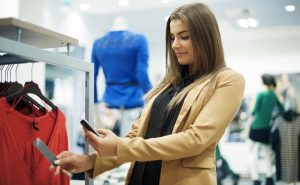[av_textblock size=” font_color=” color=” custom_class=”]
Improving Valentine’s Day with Omnichannel Personalization
Whether you think Valentine’s Day is a trumped up Hallmark Holiday, a childhood memory of tiny cards and chalky confections or a special day to celebrate your soulmate, you have to admit it was a lot easier this year than it used to be. The days leading up to February 14th usually meant a crowd of desperate dudes in a CVS aisle contemplating a battle royale over the last box of chocolates. Sure, love was in the air but, the hassle factor meant your Valentine was probably going to smell the same old roses again.
This time it was actually fun, because of technology – specifically, omnichannel personalization. I know that’s not a popular perspective, because we love to blame tech for the world moving too quickly and making us feel more isolated than ever. It’s also difficult to associate words like omnichannel, hyperpersonalization and big data with the most romantic holiday of the year. Not exactly pillow talk for consumers, but time-constrained romantics like me were happy companies were talking about it.
Making OmniChannel Personalization Work
Behind the scenes, brands were truly saving us by serving up infinite choice, inspiration and convenience. It took on many forms like targeted ads, ideal discount codes, a helpful nudge in an email or a message from that app you forgot you downloaded the year before.
And it wasn’t just the myriad of channels they were using that made things better. It was also the personalized experience. Average marketers tell you what you looked at or bought last time, but this year the good ones were giving out-of-the-box ideas. They helped us avoid the digital equivalent of yesterday’s long lines…the endless online form. We didn’t have to provide our first-born and a blood sample to create a relationship with a brand. They recognized us when we returned and we picked up where we left off. These technologies were the difference between Valentine’s bliss or a night in the dog house.
My Personalized Valentines Experience
What did all this mean for this hopeless romantic this year? It went something like this…
I finally responded to the Nordstrom email I’d been ignoring for weeks with a subject line I interpreted to say, “You’re not seriously going to push this to the last minute again, are you, moron?!” Their app had a perfect gift idea based on previous purchases I’ve made for my wife so I was literally checked out in a minute or two. I was feeling pretty good about myself.
A week later an app push from Open Table with a suggested reservation at our favorite restaurant took seconds to set up. The restaurant knew me from their loyalty program and reached out via a call to offer sprinkled rose peddles on the table and chilled champagne. Brilliant – I almost felt like I was showing off!
I thought I was done, but that last second banner ad and offer code from Shari’s Berries couldn’t be skipped. Besides, I had to be the only one that got such a sweet offer, right? I went online to pick my specially designed chocolate covered strawberries and before I knew it they slid a dozen roses in the order, too. You know how they got me to do that trite retread of a gift? They reminded me my Wife loves multiple small gifts over one big one and they could send them on consecutive days! I could already hear her telling me I was the greatest Husband in the world as I hit “Complete Purchase.”
By the way, if you’re you saying “hopeless romantic must mean sucker” you may be right, but in less than five minutes of effort I was way ahead of all those other suckers staring at an empty card shelf and sweating profusely.
The impact of personalization didn’t end with shopping or dinner. My house racked up points, too. The “romance setting” for the blinds and lights in the home automation app set the mood along with the personalized Spotify channel in Sonos. Of course, the DVR remembered my preferences so I didn’t even think about the game I was missing (I may be a Romantic, but I have other interests).
Yes, the perfect Valentine’s Day was out there for all of us if we were willing to embrace omnichannel personalization…as well as our valentine’s.
[/av_textblock]
[av_hr class=’default’ height=’50’ shadow=’no-shadow’ position=’center’ custom_border=’av-border-thin’ custom_width=’50px’ custom_border_color=” custom_margin_top=’30px’ custom_margin_bottom=’30px’ icon_select=’yes’ custom_icon_color=” icon=’ue808′]
[av_one_full first min_height=” vertical_alignment=” space=” custom_margin=” margin=’0px’ padding=’0px’ border=” border_color=” radius=’0px’ background_color=” src=” background_position=’top left’ background_repeat=’no-repeat’ animation=”][/av_one_full]
[av_one_full first min_height=” vertical_alignment=” space=” custom_margin=” margin=’0px’ padding=’0px’ border=” border_color=” radius=’0px’ background_color=” src=” background_position=’top left’ background_repeat=’no-repeat’ animation=”][/av_one_full]
[av_one_full first min_height=” vertical_alignment=” space=” custom_margin=” margin=’0px’ padding=’0px’ border=” border_color=” radius=’0px’ background_color=” src=” background_position=’top left’ background_repeat=’no-repeat’ animation=”][/av_one_full]




